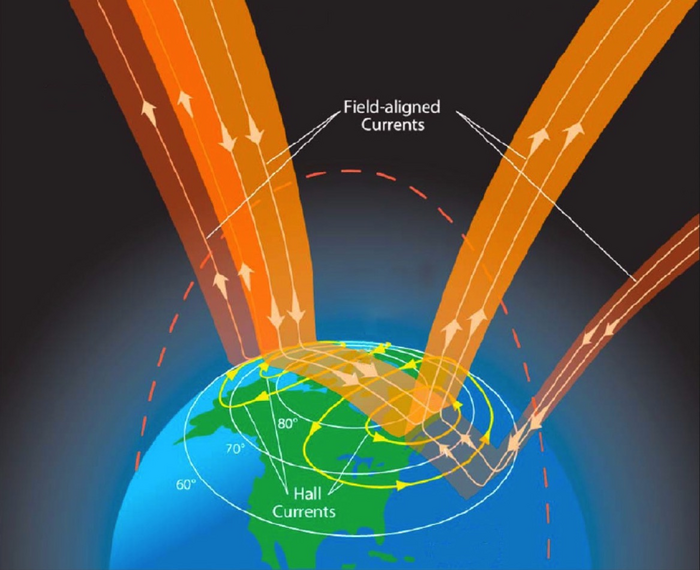A NASA-funded rocket mission is headed to space to measure the global electric circuit underlying the northern lights. For its second trip to space, the Aurora Current and Electrodynamics Structures II, or ACES II, instrument will launch from Andøya Space in Andenes, Norway. The launch window opens Nov. 16, 2022, at 6 p.m. local time.

Credit: NASA
A NASA-funded rocket mission is headed to space to measure the global electric circuit underlying the northern lights. For its second trip to space, the Aurora Current and Electrodynamics Structures II, or ACES II, instrument will launch from Andøya Space in Andenes, Norway. The launch window opens Nov. 16, 2022, at 6 p.m. local time.
High above us, electrons from space stream into our sky. As they wind down Earth’s magnetic field lines, they strike gases in our atmosphere, causing them to glow. From the ground, observers see effervescent ribbons of ruby and emerald: the aurora borealis and australis, or northern and southern lights.
But auroras are just one part of a much larger system. Like a lightbulb plugged into an outlet, they are powered by a larger electrical circuit connecting our planet to near-Earth space.
“It’s these incoming high-energy electrons that produce the auroral display we’re familiar with, but there’s also part of the system that is unseen,” said Scott Bounds, a physicist at the University of Iowa and the principal investigator for the ACES II mission.
Just as charged particles flow in, a stream of charged particles flows from our atmosphere back out to space. Together, this inflow and outflow complete a global electrical circuit known as the auroral current.
One of the biggest mysteries about the auroral current is what happens at the “turnaround point,” where the inflow ends and the outflow begins. This turnaround is in the ionosphere, a layer of our atmosphere that begins some 40 miles overhead and extends into space, where charged particles and neutral gases coexist and interact.
The ionosphere is like a bustling border town where travelers from different lands, unfamiliar with each other’s customs, meet and exchange their wares. Those arriving from above are electrically charged particles from space. Accustomed to the wide-open pathways of space, they rarely collide with one another. Their electric charge keeps them tethered to Earth’s magnetic field lines, which they twirl around as they nosedive into our atmosphere or outwards into space.
Those arriving from lower altitudes are neutral gases from our air. They bump through dense crowds, bouncing back and forth hundreds of times a second. Without an electric charge, they move freely across magnetic field lines as they are carried about by the wind.
In the ionosphere, these two populations merge – colliding, combining with one another and separating again, and interacting in complex ways. It is a chaotic scene. And yet, this turbulent mixing in the ionosphere is what keeps the auroral current churning.
To date, most studies of the auroral current have only measured inflow and outflow from high above the ionosphere, making simplifying assumptions about what’s happening below. ACES II was designed to remedy that, taking a “snapshot” of the complete auroral current at one moment in time. The strategy is to fly two rockets: a “high-flyer” that will measure particles flowing in and out of our atmosphere, and a “low-flyer” that, at the same time, will see the dynamic exchange in the ionosphere that keeps it all flowing.
At the Andøya Space Center in Andenes, Norway, the auroral oval – the magnetic “ring” encircling Earth’s northern magnetic pole within which auroras form – passes overhead each night. Bounds and his team will wait until the auroral oval is overhead – their clue that the auroral current is flowing above them.
The team will then launch the high-flyer, aiming for a peak altitude of about 255 miles (410 km). Its goal is to see the streams of particles flowing into and out of our atmosphere. Roughly two minutes later, they will launch the low-flyer through the lower parts of the ionosphere, peaking at about 99 miles (159 km). Its goal is to capture the energy exchange happening at the turnaround point, where inflow turns into outflow. The trajectories of the two rockets are aligned in space and time, to ensure they are measuring different parts of the same current. Like all sounding rockets, both the high- and low-flyer will make their measurements and fall back to Earth a few minutes later.
The ACES instrument has flown once before, launching from the Poker Flat Research Range in Fairbanks, Alaska, in 2009. There, it flew through an active, turbulent aurora. It was like measuring the weather during a particularly stormy day.
“We got great results, but what we want to understand for this flight is the ‘average case,’” Bounds said. Andøya is located much closer to Earth’s magnetic north pole, meaning milder, more typical auroras that don’t spread as far south are more accessible.
If all goes as planned, ACES II will help scientists model the auroral current as a whole, including its trickiest part: our ionosphere.
“This is just a single case – it doesn’t answer all questions,” Bounds said. “But it gets us a data point we need.”




